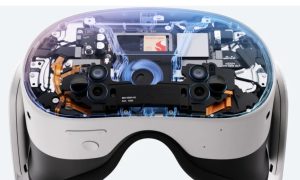 The Splinter Cell series has had a pretty fantastic run so far, with nearly every game scoring mid-80s or much higher. That said, Splinter Cell: Conviction received a little more of an icy reception (though it scored well with most outlets) for a few nagging technical issues and some head-scratchingly absent gameplay mechanics. Over the last three years, Ubisoft went back to formula with one obvious goal — bring back classic Splinter Cell. Now, with the release of Tom Clancy’s Splinter Cell: Blacklist we step back into the jet-black boots of Sam Fisher.
The Splinter Cell series has had a pretty fantastic run so far, with nearly every game scoring mid-80s or much higher. That said, Splinter Cell: Conviction received a little more of an icy reception (though it scored well with most outlets) for a few nagging technical issues and some head-scratchingly absent gameplay mechanics. Over the last three years, Ubisoft went back to formula with one obvious goal — bring back classic Splinter Cell. Now, with the release of Tom Clancy’s Splinter Cell: Blacklist we step back into the jet-black boots of Sam Fisher.
The first and most noticeable change is obvious – Eric Johnson has replaced the grizzled and well-aged voice of Michael Ironsides (You might recognize Johnson from his work in Smallville and Rookie Blue). His performance is a little bit uneven, a little over the top, and, whether we like it or not the new voice of our favorite quasi-governmental spook. The rest of the voice actors in the game (including Elias Toufexis, the voice of Adam Jensen in Deus Ex: Human Revolution) turn in pretty decent performances. Given the intensity of the situation, they all seem a little on edge when they should, and newcomer Charlie deflects with humor in a natural way.
[singlepic id=7390 w=320 h=240 float=left]The story that gives the voice actors the canvas on which they paint is an unfortunately plausible scenario. The United States has over 170,000 soldiers deployed in 150 countries throughout the world, and it turns out that is a fantastic way to make a few enemies. A group calling themselves “The Engineers” has grown tired of the Western agenda and they have formulated The Blacklist to convince us to bring all of those troops home. The Blacklist is a list of American interests both home and abroad that The Engineers will attack and destroy over a short span of weeks should we choose to ignore their ultimatum. After severe cracks in Third Echelon’s security, and the actions of (REDACTED) at the end of Splinter Cell: Conviction, the agency is dismantled. With this new threat, Sam and Grim are tasked to form Fourth Echelon – a new agency agile enough to strike worldwide in clandestine operations with very little operational oversight. With Sam as the leader of this new organization, can he act fast enough to avert global catastrophy?
Blacklist may look, at least on the surface, like a franchise reboot. It is actually a direct sequel to Conviction, canon intact. The government grants Sam a C-147B (or C-159, if you follow the trailers) called Paladin – a huge cargo aircraft converted into a mobile base. This base is your hub of operations, also serving to blur the lines between single player and multiplayer courtesy of the SMI, or Strategic Mission Interface. A massive Surface touchscreen display, the SMI gives you the map view that allows you to select any of the missions in the game. This means there is no ‘multiplayer’ menu option, no co-op, no Live, etc. — you do it all from within the game, right at the Command and Control section of the Paladin. You can also talk to the various people on the Paladin for the same options, albeit with a bit more context from their point of view. We’ll get back to cooperative play in a moment.
The biggest question on every Splinter Cell fan’s mind is, what title is this most like? Well, all of the talk from the team about ‘action gamers’ would have you thinking it’s Conviction all over again, but that’d be incorrect. While it doesn’t quite live up to the incredible Chaos Theory, it may just be a close second. Starting off with four difficulty levels, including the much-anticipated and unforgiving “Perfectionist” level, the game puts together the best parts of all of the Splinter Cell titles from this generation, and introduces new elements to take it to another level.[singlepic id=7393 w=320 h=240 float=right]
Sam has always had the most incredible equipment, including the franchise-logo-fodder goggles, his silenced pistol, and the trusty FS2000 rifle. Gadgets are doled out over time, and by the end of the game, Sam’s pockets are overfull with goodies. In Blacklist, the formula is different. Each mission, whether it be cooperative, Spies vs. Mercs, or the single-player campaign, nets you cash to spend on the various equipment unlocked through upgrades to the Paladin – another use for your hard-earned cash. Since your finances are shared in every game mode, you’ll need to use the cash to upgrade your multiplayer characters as well.
Sam’s gear varies quite a bit from previous games. Torso, gloves, pants, boots, goggles, and headgear make up your non-shooty equipment, granting stealth, armor, faster reload speeds, and more depending on the level of the gear. Weapons beyond the basics are purchased, as are the available upgrades. Scopes, laser sights, match-grade ammunition and more grant additional advantages in the field, for a price.
[singlepic id=8329 w=320 h=240 float=left]The amount of cash you receive is largely dependent on how you play. There are three identified playstyles – Ghost, Panther, and Assault. Ghosts stick to the shadows, remaining undetected, and killing no one. The Panther is quiet, yet lethal. He cuts down his foes in a permanent fashion while remaining stealthy. The Assaulter goes in guns blazing, killing foes with unsilenced weapons, and uses hand to hand in a lethal fashion. I am almost exclusively a Ghost player, but I took the fight to my foes a few times to try it out. The end result was a mixture of knockouts, combat kills, and stealth kills that netted me a very similar dumptruck of cash than if I had stuck to just one style. It’s clear that it’s used more as a gating system than a restrictive one – you won’t be forced to choose too often. You can upgrade the Paladin as well, but it too gates other equipment options and choices. There are some equipment options that are locked until you complete all of the optional side missions, whether that be solo or with a friend. If you play Splinter Cell: Blacklist as a stealth title instead of a Call of Duty clone, you’ll have more cash than you’ll need.
The single player game takes roughly 14 hours to complete, with more than a dozen side missions doled out by your crew. The Spies vs. Mercs mode has also returned, granting the fantastic asymmetric gameplay brought to us by Pandora Tomorrow. In Blacklist we get the original 2v2 mode, but we also get a new 4v4 mode. Essentially, the non-lethal Spies are charged with hacking one of three objectives. They play in the third-person perspective, can climb and utilize the verticality of a map, and have a great deal of gadgets to accomplish their missions. The Mercs play from the first-person perspective, are extremely lethal, and carry flashlights to spot rogue spies wherever they might hide. Gadgets as you level up tweak the formula, giving you cloaking, scanning, and much more. If you are unfamiliar with the mechanics of the mode, you might want to check out this video for a quick overview.
The mode turns out FAR better than you might imagine. 2v2 (Classic mode) is the tense and hair-raising mode you remember it to be, but 4v4 (Blacklist mode) changes the game completely. Having eight players roaming the halls makes coordination much more necessary, driving the ebb and flow of missions. Oh, but wait…spies have lethal weapons now. Hiding in the dark and ambushing your enemies just got a whole lot more interesting.
Cooperative play comes courtesy of newcomer Isaac Briggs – a 4th Echelon player that gives Sam something he’s not had up until recently — direct in-field support. He is also the second player when you join any of the secondary missions. Later in the single player mission structure you even get a chance to play a short few moments in his boots, but I won’t ruin that for you. Suffice it to say, the game isn’t just sneaking and shooting – there are a few surprises to be had, shaking up the status quo mission types.[singlepic id=10317 w=320 h=240 float=right]
Beyond the single player and multiplayer mission fun, there is also “Shadownet.” Shadownet grants players access to challenges that rotate on a timed basis. These can be getting 25 headshots with a rifle in the next 24 hours, 20 kills with a black market SMG in the single player game, getting to a certain level in Spies vs. Mercs in the next week, or any number of other opportunities to earn a little more cash.
There are a few things that aren’t as rosy as I’d like in Blacklist. Even with the optional 3GB high-resolution textures installed, there is occasionally some odd texture tearing, and occasionally you or AI players can get stuck in the environment (I found myself hung up on doorways most often). It’s not pervasive, but when it happens, you’ll notice. The framerate remains solidly locked, despite the fantastic level of detail. This is a great end-of-generation example of what can be done with the Unreal 3 engine, and it’s pretty to look at.
[singlepic id=12443 w=320 h=240 float=left]I was very surprised to see just how well split-screen co-op works. I normally hate it with a passion, but David and I sat down for some couch co-op sneaking, finding it to be a solid offering. Vertically split, the co-op options work for all side missions in the game, with the exception of Spies vs. Mercs. The framerate remains stable on this mode as well, regardless of how far away the players happen to be.
Mark and Execute returns from the previous game, though it is not nearly as necessary as it was in the previous title. This time around you can use it with any weapon in your arsenal, including the crossbow and stun gun with their non-lethal options. Both are now sight-limited, so you can’t mark a target halfway across the map and then execute them from a football field away. Some guards also wear body armor, including helmets, so lower-powered weapons will unceremoniously pop their helmet off with an audible plink.
There is one item that is systemic to the Xbox 360 – disc switching. Splinter Cell: Blacklist ships on two DVDs, and installing them both to the hard drive still requires you switch to the second disc mid-way through the game. Unfortunately, should you decide to hold off on the side missions and then go back to them later, you’ll be switching discs again. This problem doesn’t exist on the digital version of the game on the PC, nor on the Blu-ray-based PS3 version, obviously.[singlepic id=8332 w=320 h=240 float=right]
Splinter Cell: Blacklist is, by far, one of the best Splinter Cell titles to date. The cat-and-mouse action and revamped stealth elements give Sam’s franchise a fresh coat of paint, even if we’ve lost our favorite grizzled voice actor in the process. It’s great to see Spies vs. Mercs return, and hopefully it is here to stay this time around. Sneaking is more fun than ever, and the unified economy and challenge system rewards the player for playing all of the included modes. There are some minor nitpicks, but they are hardly even worth mentioning. Splinter Cell: Blacklist doesn’t ever constrain the player, offering multiple play styles that extend the game for multiple playthroughs. It’s amazing to see how much the team has listened to fan feedback, and just how far ahead this title is compared to Conviction. If sneaking is your speed, you can rest easy – Sam Fisher is back, and Splinter Cell: Blacklist is among the very best stealth titles you’ll play this generation. It whets the appetite for what’s possible for the next time we see Sam again.
Ron Burke is the Editor in Chief for Gaming Trend. Currently living in Fort Worth, Texas, Ron is an old-school gamer who enjoys CRPGs, action/adventure, platformers, music games, and has recently gotten into tabletop gaming.
Ron is also a fourth degree black belt, with a Master's rank in Matsumura Seito Shōrin-ryū, Moo Duk Kwan Tang Soo Do, Universal Tang Soo Do Alliance, and International Tang Soo Do Federation. He also holds ranks in several other styles in his search to be a well-rounded fighter.
Ron has been married to Gaming Trend Editor, Laura Burke, for 28 years. They have three dogs - Pazuzu (Irish Terrier), Atë, and Calliope (both Australian Kelpie/Pit Bull mixes), and an Axolotl named Dagon!

See below for our list of partners and affiliates:

























